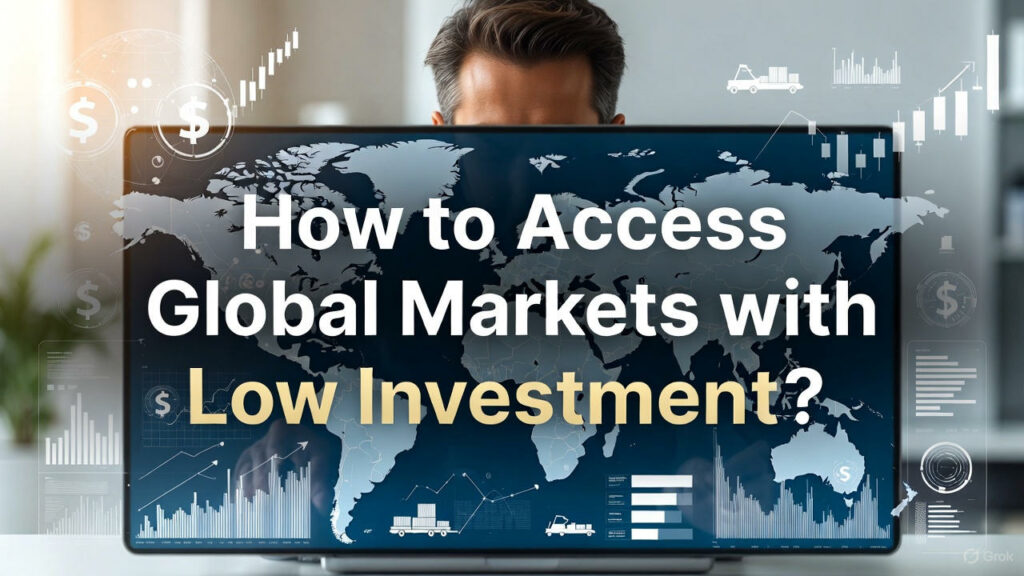“95% of the world’s consumers live outside your domestic market.” – World Bank
This single statistic shows why businesses of all sizes, from small exporters to fast-growing startups, are increasingly looking outward. Until recently, the idea of expanding globally was seen as something only large corporations with massive budgets could attempt. But today, technology, digital trade platforms, and smart financing tools have leveled the playing field.
For small businesses and MSMEs, it’s no longer a question of if but how they can access global markets with low investment. The truth is, you don’t need deep pockets to take your products or services abroad. What you need is the right strategy, digital adoption, and an understanding of the opportunities waiting for you.
This blog will discuss how to access global markets with low investment, the importance of small export business, the opportunities in international trade for MSMEs, and some handy tips such as low cost global expansion, creating an online export business and startup global reach.
👉 “Know How a Project Report Secures Your Bank Loan Approval“
What Does It Mean to Access Global Markets With Low Investment?
The ability to reach the global market no longer necessitates establishment of offices in other countries, recruiting numerous employees, or allocating substantial funds to the construction of infrastructure. Instead, nowadays companies use e-commerce, trade platforms, fintech, and government export programs.
Digital trade lowers the cost of entry into global markets by up to 60 percent lower than the traditional models as stated by the International Trade Centre. This implies that you can sell your products abroad, even when you have a small business with low funds.
Access global markets with low investment simply implies applying intelligent and resource-saving tactics to get you access to international markets without stretching your budget to its limits.
The Role of Small Export Business in Global Trade
Small exporters are the unknown heroes of international trade. In India, SEB is contributing almost 45 per cent of the total exports (Ministry of Commerce, 2024).
These companies show that you do not have to be a multinational corporation in order to thrive in the global environment. A handicrafts maker in Jaipur is able to send products to Europe through Etsy. Amazon Global will help a textile company in Kerala to expand to the Middle East.
What is so powerful about a small export business?
- Lower set up costs than big exporters.
- The capability of responding swiftly to niche market requirements.
- More accessible to utilize online channels to be seen.
For entrepreneurs, the lesson is clear: don’t underestimate the power of starting small.
Opportunities in International Trade For MSMEs
The SMEs also contribute 30 percent to the GDP of India and 48 percent to the total exports (MSME Annual Report, 2023). However, some are still afraid to venture into the international markets because of regulatory concerns, logistics or financing shortcomings.
Things are changing however. Governments are globally taking proactive action to facilitate international trade for MSMEs.
- RoDTEP and MEIS schemes in India.
- Entry into international trade fairs and B2B.
- Less cumbersome cross border digital payments.
A survey conducted by the World Bank established that MSMEs that engage in international trade expand at a 20 percent faster rate than those that trade within their countries. That means global trade is not only an opportunity but a survival and growth necessity.
Strategies for Low-Cost Global Expansion
The first fear is cost when we think of going global. However, low cost global expansion can be achieved through the correct strategy.
These are tested methods:
- Take advantage of Free Trade Agreements (FTAs): These lower the tariffs and open up duty-free exports in various countries.
- Use Digital Marketplaces:These market places such as Alibaba, Amazon Global and TradeIndia have sellers to global buyers.
- Work with the existing distributor: You do not have to open your own office there, but collaborate with a local distributor.
- Adopt Cloud-Based OperationsSave on infrastructure costs by adopting the use of SaaS applications in accounting, communication and customer care.
McKinsey research shows that businesses using digital-first trade strategies achieve 2x faster market entry compared to traditional exporters.
👉 Check our bank-ready project report samples now!”
Building an Online Export Business: The Digital Gateway
International e-commerce is not an option anymore, it is a necessity. It is projected that by 2030, the cross-border e-commerce market will be worth 7.9 trillion dollars (UNCTAD).
This is why establishing an online export business is one of the wisest ways to take advantage of the global opportunities.
Plans to consider:
- Amazon Global Selling – Sell in 200+ countries.
- Alibaba – B2B site, which is best suited to manufacturers and wholesalers.
- Shopify – Create your own branded online shop with worldwide shipping.
- Flipkart Export – Expand abroad through the use of Indian e-commerce.
Case Study: A Kerala-based startup that sells organic spices increased its sales by 200 percent in two years by targeting the NRI buyers through online platforms.
The point is straightforward: an online export business is something that eliminates all the obstacles and enables even small players to compete with the whole world.
Achieving Startup Global Reach Without Big Budgets
When it comes to startups, new markets are an intimidating thought. However, in practice, the goal of startup global reach is to be lean and strategic and not spend millions.
The PwC Startup Survey (2024) found out that 72 percent of startups consider global expansion the key to long-term growth.
How startups can be globalized on a shoestring:
- Lean Operations: Leverage co-working, distributed teams and cloud-based solutions.
- Partnerships: Co-operate with international distributors or accelerators.
- Digital-first Strategy: Promote the products online with the help of online marketing and search engine optimization that target global consumers.
- International financing: Access international investors or crowdfunding sites.
The flexibility of operations enables startups to reach the global market at a minimum cost.
Practical Checklist: How SMEs Can Access Global Markets With Low Investment
Here’s a quick checklist to help SMEs and startups take action:
- Identify target markets using free tools like Google Market Finder.
- Apply for government export subsidies and schemes.
- Build professional financial project reports to attract funding.
- Use fintech and digital banking platforms for seamless compliance.
- Collaborate with chartered accountants and export consultants for credibility.
Conclusion: The Smarter Way Forward
The notion that only big companies can be successful in the international arena is obsolete. Small export business can excel even in the global trade nowadays with the appropriate tools and strategies.
With access global markets with low investment, SMEs and startups can:
- Expand faster.
- Minimize risks.
- Gain trust with foreign customers.
Platforms as Finline can facilitate this process by assisting businesses to create professional and bank-ready project reports in less than 10 minutes. By reducing the amount of manual work and making it accurate, Finline allows entrepreneurs to concentrate on their growth rather than paperwork.
It is the end of the day that global trade is no longer about who has the deepest pockets. It is about the smartest way of going about it. With the current tools, any entrepreneur can get an opportunity to win in the global market.
Create your bank-approved project report with Finline today!









